- Contents
My web page
Entering the Data for a VA Loan
For ease of reference, we will generally use the term “DU” to refer to Desktop Originator® and Desktop Underwriter® (DO®/DU®).
This document shows you how to create a new VA loan casefile in DU and explains how to enter the minimum amount of data necessary to receive an underwriting recommendation for a VA loan.
-
The Loan List is the first screen you see when you log in to DU. You can use the Loan List to create or import a loan or to view a list of existing loan casefiles you want to see. To create a new loan casefile for the loan, click Create Loan.

Note: If your user ID allows access to multiple institutions (branch locations), a screen appears to allow you to select the institution under which you want to create the loan casefile. Select the institution you want to use, then click Continue.
-
A new Quick 1003 opens. The Quick 1003 is an electronic version of the Uniform Residential Loan Application (Fannie Mae Form 1003).
The first screen in the Quick 1003 allows you to enter the applicant's name and Social Security number under Borrower Information. Enter the same information for the co-applicant, if any, under Co-Borrower Information.

Note: If the borrower or co-borrower uses a different mailing address than the present address, enter this information in the Mailing Address section.
Tip: If the borrower and co-borrower share the same present address or mailing address, you can quickly copy the address to the co-borrower’s side of the screen by clicking the Present Address or Mailing Address check box on the co-borrower’s side of the screen.
When completing this section, keep the following points in mind:
-
-
The borrower and co-borrower must be married to be eligible for VA automated underwriting.
-
For VA loans, the No. of Dependents field is required for both the borrower and the co-borrower. List each dependent only once, under either the borrower or the co-borrower. If a borrower has no dependents, enter 0. If the subject property is in a non-community property state and the veteran’s spouse is not included on the loan application, be sure to include the spouse as a dependent.
-
You should enter a two-year residency history for each borrower. If you need to enter previous residency information, click Previous Address Information in the navigation bar on the left side of the Full 1003.
-
-
To continue entering data, you can click Next to continue to the next screen in the Quick 1003, or you can click one of the links in the navigation bar on the left side of the Quick 1003.
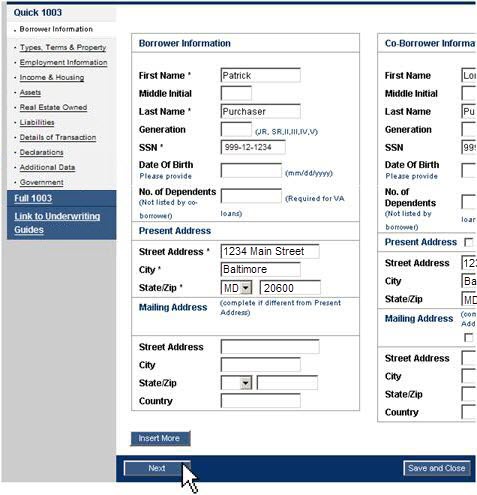
Note: At this point, you have sufficient information to order or reissue credit reports for the borrowers on the loan. In order to pull a joint credit report for two applicants, both applicants would need to be on the same loan application in DU. For details, see Ordering a new credit report or Reissuing a credit report.
Tip: When you create a new loan, you must complete the Borrower Information screen before you can request a credit report or enter data into any of the other sections. Once you finish entering the borrower information, you can move freely to any other section.
-
Enter data for the Type of Mortgage and Terms of Loan and for the Subject Property Address and Purpose of Loan. At the top of this screen, enter the necessary mortgage data.
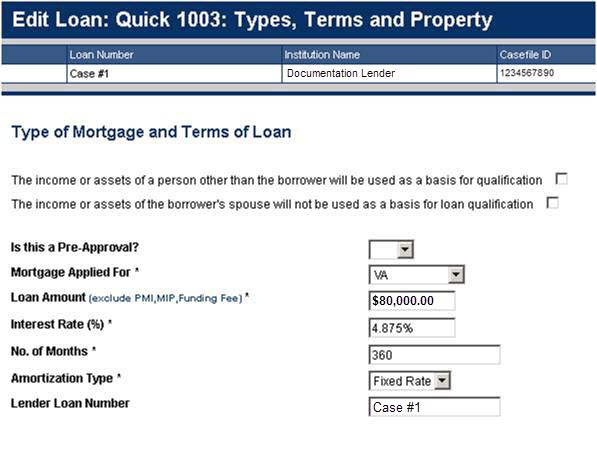
The following information is required for a VA loan:
-
-
In the Mortgage Applied For field, select VA.
-
In the Loan Amount field, enter the amount of the base mortgage without the VA Funding Fee.
-
In the Amortization Type field, select Fixed Rate or ARM. The other selections are not supported for VA loans.
-
-
Scroll down to the Subject Property Address and Purpose of Loan section and enter the necessary data. In the Occupancy field, select Primary Residence. The other selections are not supported for VA loans.
To continue, click Next.
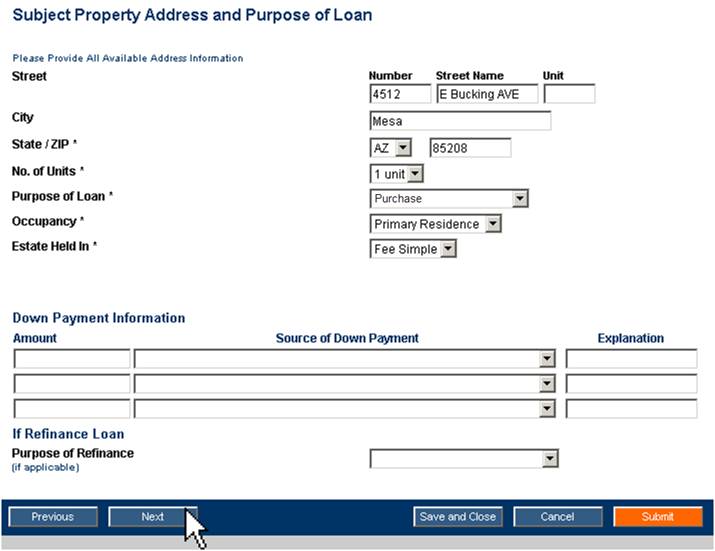
-
If you clicked Next in Step 5, the Employment Information screen appears. Enter the name of each borrower’s current employer and the number of years and months each borrower has been on the current job. For each job you enter, you must select Yes or No in the Self Emp field to indicate whether the borrower is self-employed on that job.
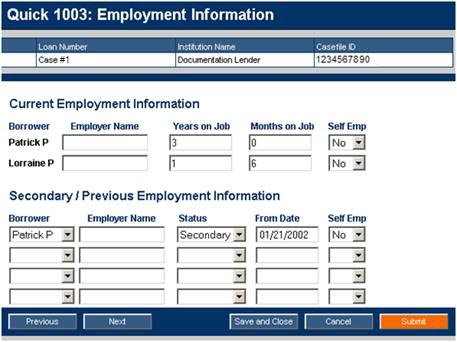
Note: Do not use the Employment Information screen to enter data for a homemaker, full-time student, or retired borrower. Only active employment information should be entered in this screen. If you enter any data in the Employer Name field, you will receive a Findings message that asks you to verify the employment. Any income that does not come directly from employment should be entered in the Other Income section of the Monthly Income and Combined Housing Expense screen.
If a borrower is currently working at a second job, enter the data for that job in a separate row under Secondary/Previous Employment Information, and select Secondary in the Status field.
Tip: In some cases, you may also need to enter information about a borrower’s previous employment. To enter data for a previous job, use a separate row under Secondary/Previous Employment Information, and select Previous in the Status field.
To continue, click Next.
-
The next section in the Quick 1003 allows you to enter data about the borrowers’ income and current and proposed housing expenses.

Enter the necessary data about the borrowers' monthly income at the top of the screen. Here are a few data entry tips:
-
-
The Base Income field should include income from non-military employment, including any income from jobs that were listed as second jobs in the Employment screen.
-
All military income should be entered under Other Income.
-
The Other field shows the total of the amounts entered under Other Income. To place an amount in the Other field, you’ll first need to scroll down to the Other Income section and enter the data there.
-
Important: Net rental income should not be entered on this screen. Instead, the net rental income will be automatically calculated from property data entered in the REO screen. DU uses the net rental amount from the REO screen when processing government loans.
Note: The following income types are used for conventional loans only and will result in an error if selected: Capital Gains, Employment Related Assets, Foreign Income, Royalty Payment, Seasonal Income, Temporary Leave, Tip Income, Non-Borrower Household Income, Accessory Unit Income and Housing Choice Voucher Program (Section 8).
-
Scroll down to the Combined Housing Expense section and enter the necessary data about the borrowers' current and proposed housing expenses. DU calculates the totals for you.
To continue to the next screen, click Next.
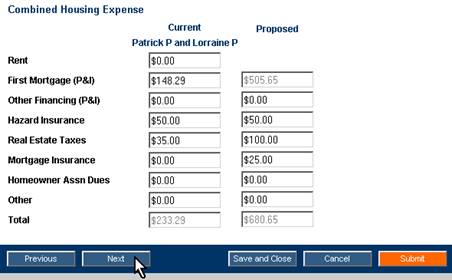
-
In the Assets screen, enter the borrowers' asset information.
To continue to the next screen, click Next.
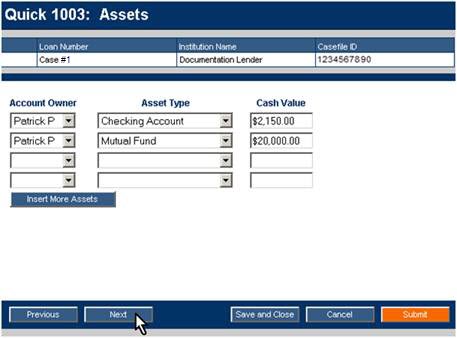
-
The Real Estate Owned screen appears. For each property, complete the following fields on this screen:
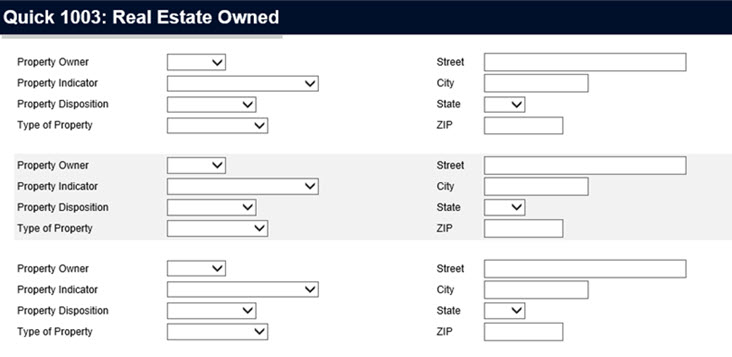
-
Select one of the following options in the Property Indicator field:
-
Select Current Residence if the property is the current primary residence, but not the subject property.
-
Select Refi of Current Residence if the property is both the borrower’s current primary residence and the subject property for the transaction. Select this option for refinance transactions.
-
Select Not Applicable if the property does not meet the above conditions.
-
-
Note: The Subject of the Loan option is generally not applicable for VA loans.
-
-
Enter the property street address, city, state, and ZIP code.
-
Select the property owner.
-
Select one of the following options in the Property Disposition field for each property listed:
-
Select Sold if the funds from the sale have already been placed in a depository account.
-
Select Pending Sale if the property will go to closing before the closing of the subject loan, but the funds from the sale have not yet been placed in a depository account.
Tip: The result of the pending sale calculation, which is (Market Value x 90%) – Amt of Mtg Liens, can be overridden by entering Net Equity in the Asset section. -
Select Rental if the applicant is using the property as a rental property.
Tip: The result of the net rental income calculation, which is (Gross Rental Income x 75%) – (Mtg Payments + Insur, Maint, Taxes), can be overridden by changing the amount in the Net Rental Income filed. Note: Net rental income should not be entered in the Income & Housing section, but the amount in the Net Rental Income field will be displayed in Income & Housing section. -
Select Retained if the property will still belong to the applicant after closing. For example, you would select Retained for a refinance or for a second home that is already owned by the borrower.
-
-
Scroll to the right to enter data in the remaining fields.
-
-
The quickest way to use the Liabilities screen is to let DU copy the liabilities for you from the credit report. To do this, you will use the auto-populate liabilities feature in the credit ordering screen. For details, see Ordering a new credit report or Reissuing a credit report.
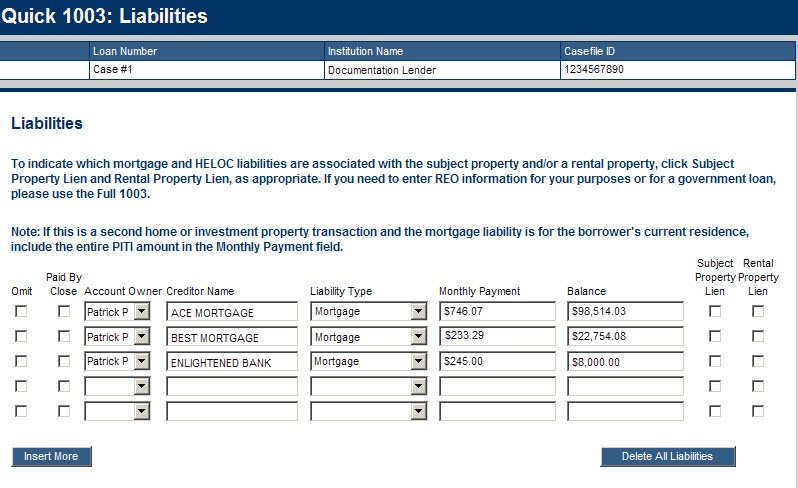
For each mortgage liability, use the Related Property field to select the property to which the mortgage applies.
To insert additional liabilities, click Insert More. -
If an applicant has a child support, alimony, separate maintenance, job-related expense or other expense, and the payment is required to be included in the total expense ratio per VA’s guidelines, you must enter the monthly payment amount in the Additional Expenses section at the bottom of the Liabilities screen. If applicable, you must also answer Yes to Question G in the Declarations screen for the appropriate borrower.
Note: If you enter a monthly payment amount but you don’t enter a number in the Months Left to Pay field, the payment will always be included in DU’s total expense ratio calculation.
To continue to the next screen, click Next
.
-
Enter the necessary data in the Details of Transaction screen.
To continue to the next screen, click Next.
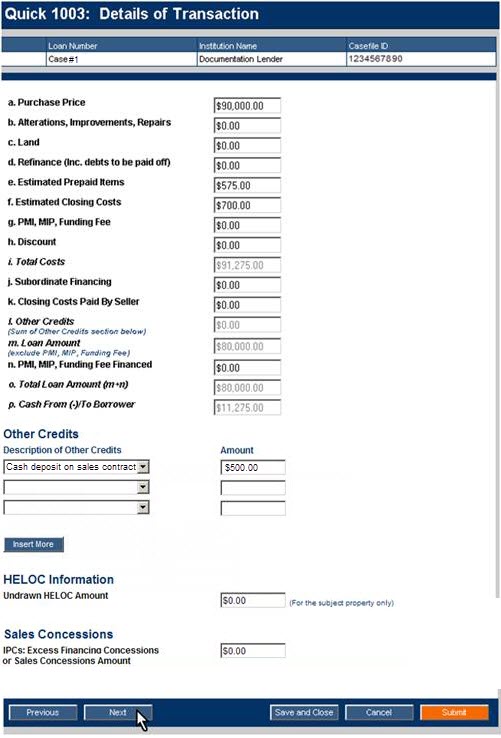
-
By default, most of the questions at the top of the Declarations screen are already answered for you. You need to make sure that these answers are accurate. Before you submit the loan casefile for an underwriting recommendation, you must also provide an answer to Question L for all borrowers.
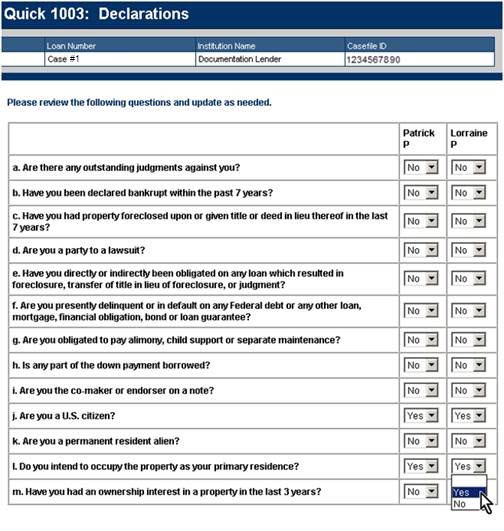
-
Scroll down to the Information for Government Monitoring Purposes section and enter the necessary data. When appropriate, you can select multiple race categories for each individual borrower.
Note: For applications taken by telephone, you must ask for this information, but you cannot require the applicant to provide it. You should inform the applicant that the federal government is requesting this information in order to monitor compliance with federal statutes that prohibit lenders from discriminating against applicants on these bases.
For applications taken in person, you must ask for this information, but you cannot require the applicant to provide it. If the applicant chooses not to provide the information, to the extent possible, you should note the information on the basis of visual observation or surname. You should also inform the applicant that if the information is not provided, you are required to note the data on the basis of visual observation or surname.
Although the information in this section is not required to qualify a borrower (or co-borrower) or underwrite a loan, this information is required in connection with revisions to the Federal Reserve System's Regulation C (Home Mortgage Disclosure Act [HMDA]).
To continue to the next screen, click Next.
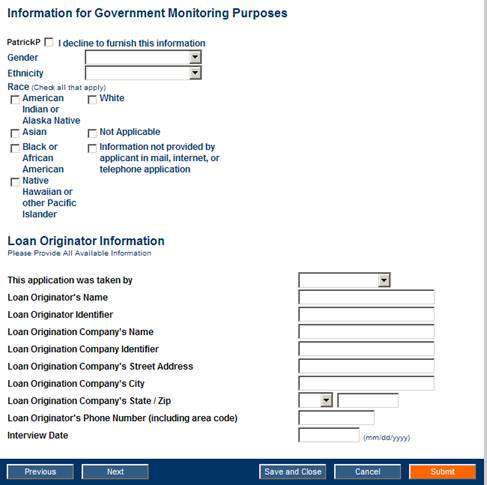
-
Enter the necessary data in the Additional Data screen. To submit a loan for an underwriting recommendation, you must always enter the property appraised value and subject property type in this screen. The other entries on this screen depend on the details of the loan you are submitting.
When completing this section, keep the following points in mind:
-
-
VA guidelines require that lenders follow standard VA procedures to review and determine the actual appraised value. If the appraised value differs from the estimated value, you will need to change the amount in the Property Appraised Value field and resubmit the loan.
-
Under Lien Type, select First Mortgage. The other options are not support for VA loans.
-
Under Subject Property Type, the following property types are not supported for VA loans:
-
-
Co-operative
-
High Rise Condo
-
Detached Condo
-
Manufactured Home:
-
Condo/PUD/Co-Op
-
MH Select™
-
-
Under ARM Plan (if ARM was selected as the amortization type), select either VA 1 YR ARM or VA HYBRID ARM. The other options are not valid for VA loans.
-
To continue to the next screen, click Next.
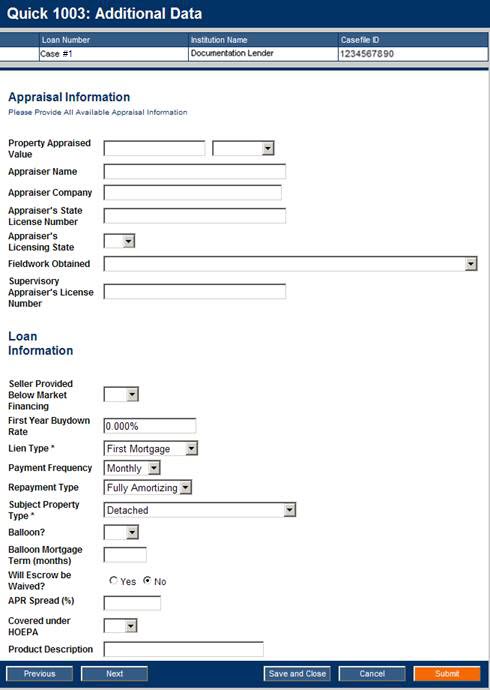
-
Enter the necessary data in the VA Government Information screen.
You do not need to enter an agency case number to receive an underwriting recommendation. However, you must enter an agency case number before you submit the loan to VA for guaranty.
Enter the remaining entitlement shown on the Certificate of Eligibility in the Entitlement Amount field.
Enter the appropriate amounts in the Maintenance and Utilities fields.
Use the Seller Concessions field to enter the dollar amount of seller concessions in excess of the VA’s limitation, if you have not already reduced the loan amount by the amount of the seller concession.
Enter the sum of all federal, state, Social Security, and local income taxes for each borrower in the Total Taxes fields.
Enter the necessary CAIVRS numbers for the loan in the CAIVRS # fields.
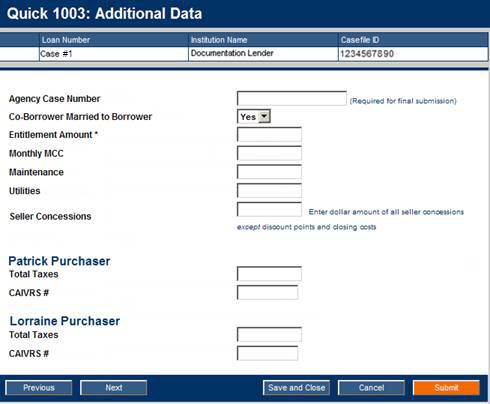
Note: The CAIVRS number is not required to submit a loan for an underwriting recommendation; however, it is required to obtain VA guaranty.
-
Once you have entered the necessary data for a VA loan, you are ready to submit the loan casefile for an underwriting recommendation.
If you have not requested or reissued credit for the loan casefile, you will need to do so at this point.
Click Submit. For details, see one of the related job aids listed below.

Related Job Aids
© 2021 Fannie Mae. Trademarks of Fannie Mae.


